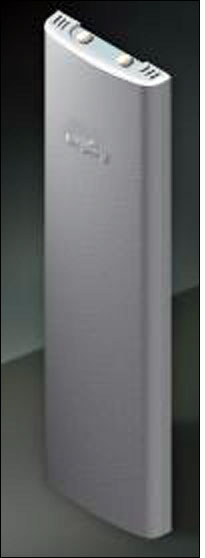Apr 06, 2010Impinj, a provider of passive ultrahigh-frequency (UHF) RFID technology, has unveiled a new UHF EPC Gen 2 interrogator, the Speedway xPortal, as well as a new reader antenna, the Dual-Linear Phased Array (DLPA). The xPortal, which includes an integrated DLPA antenna, is designed to be smaller and less expensive to install and operate than existing portal readers, which are used in doorways and other portals through which tagged items or individuals with ID badges pass. The company claims the xPortal will save users an average of $1,000 per doorway, requiring no AC power cabling and being less expensive to ship. What's more, Impinj reports, the device offers a high read rate.
According to Impinj, the system is intended to offer customers a solution to existing problems with portal readers. Currently, there are two options for portal readers, says Scot Stelter Sr., the firm's senior director of product marketing. The first is a floor-mounted steel cabinet-housed reader that can weigh 150 to 200 pounds, be unattractive and difficult to install, and require considerable energy to operate. That option also takes up considerable space, and is thus unrealistic in narrow passageways, such as some hallways that connect a retailer's storeroom to its sales floor. The other option is a "do-it-yourself" installation, Stelter says. In that case, an end user mounts readers and runs the cable necessary to power them, in addition to a local area network (LAN) connection. That type of installation, he says, "is messy and more expensive, because there is labor involved," such as a licensed electrician running the power cable.
The xPortal weighs 10 pounds, stands approximately two and a half feet tall and measures 8 inches wide by 2 inches deep. The device is designed to have a low profile while maintaining high performance, says Daniel Bowman, Impinj's senior marketing manager. The design of the antenna and reader itself allows the xPortal to consume less than 13 watts, he says, enabling it to be powered over Ethernet. This means an Ethernet cable is all that needs to be installed with the reader. Traditional portal readers draw 25 to 40 watts, Stelter notes. And while there are other interrogators that can be powered over Ethernet, he adds, the performance (read rate) is not as high as that offered by the xPortal. That read rate varies, though, he says, according to the environment and the items being tagged, it is in the very high 90th percentile. "In testing at a pilot retail customer," Stelter says, "using the xPortal improved read reliability 1 to 13 percent, depending on the product [being tagged], versus a standard Speedway Revolution reader with off-the-shelf far-field antennas in traditional steel portal stands."
To accomplish this high read rate, Impinj has deployed several of its own technology innovations. A portal, Stelter says, paints a narrow curtain of RF transmission. The Dual-Linear Phased Array, which consists of a pair of linearly polarized antennas that constantly switch from horizontal to vertical transmissions, gives the xPortal the ability to read tags despite their orientation. Typically, linear antennas must be configured to correspond with the expected orientation of the antennas within the tags passing through a portal. Another option is a circular antenna, which can capture reads from tags at any orientation, but the energy is distributed throughout that circular form, making it somewhat less efficient—and, therefore, providing a shorter read range—than linear antennas. With the DLPA, Stelter explains, the reader antennas offer the efficiency of linear antennas but the reliability of circular antennas. (Another RFID vendor that sells an interrogator that employs phased-array antennas is Mojix.)
The xPortal's two DLPA antennas transmit a 60-degree horizontal beam from left to right and an 80-degree vertical beam from top to bottom, providing complete coverage for typical portal scenarios. Autopilot's antenna switching feature automatically adjusts the amount of time the antennas spend in each state (vertical or horizontal) to optimize performance. Typically the reader will switch between states within 20 and 200 milliseconds, says Bowman.
With Autopilot, the reader can also adjust to changing RF environments, by sensing environmental noise and interference, and then responding to that external environment by adjusting its RF signal accordingly (such as increasing its read sensitivity when necessary). Additionally, the Revolution has a low-duty cycle, which means it ceases transmitting an RF signal if it fails to detect any tags within its vicinity. In this way, the device not only conserves power, but also reduces RF noise for other readers that might be in the area. The interrogator periodically pings out a signal to check if any RFID tags come within range, then resumes full operation if it receives a response.
The xPortal is designed for retail settings, offices, hospitals or other indoor environments in which tags would need to be read on files, assets, pallets or individuals passing through doorways or hallways. Generally, there would be two readers installed at each doorway, which could be mounted on a wall, the ceiling or their own bases.
The xPortal has used pilot applications involving several retailers, though Impinj declines to name the participants in those pilots. The company plans to begin shipping the product in June of this year, Stelter says, and is now taking orders. "Our message," he states, "is that if you switch to this approach [xPortal readers, rather than traditional AC-powered devices], you can save $1,000 per doorway." He notes that in a typical deployment with two readers—one on each side of a doorway—the savings would be realized in the reduced cost of installing the interrogators, as well as in the lower expenses of powering, shipping and handling them. According to Impinj, the xPortal sells for $2,495.




